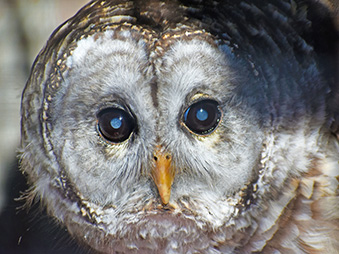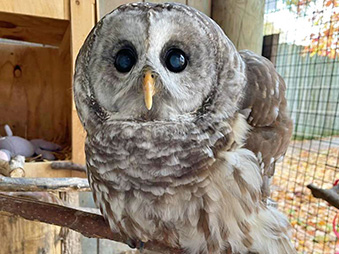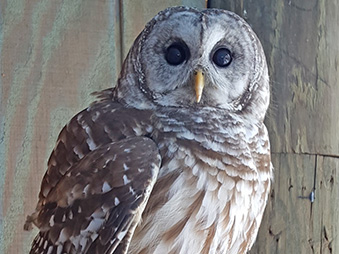Strix varia | Barred Owl
Name: Hoot (Male)



Meet Hoot: Our Barred Owl Ambassador
Introducing Hoot, our resident Barred Owl (Strix varia)! A true master of the forest, Hoot is known for his haunting calls, stealthy hunting techniques, and impressive adaptations that make him a formidable nocturnal predator.
The World of Barred Owls
Native to large portions of North America, including parts of Canada and the U.S., Barred Owls thrive in mature forests with large trees, especially near water. These environments provide ample prey and nesting sites, making them ideal hunting grounds for this highly adaptable raptor.
Barred Owls are expert hunters, using their sharp talons and powerful hooked beaks to capture small mammals, birds, reptiles, and even fish. Their unique facial structure and asymmetrical ears work like a satellite dish, funneling sound to provide exceptional hearing. This allows them to pinpoint prey even under layers of snow or dense foliage.
Unlike humans, owls cannot move their eyes independently. Instead, they must turn their entire head—an ability enhanced by their impressive 270-degree head rotation. Their large, forward-facing eyes give them excellent depth perception and night vision, making them highly effective nocturnal hunters.
Silent Flyers with a Distinctive Call
Barred Owls are highly vocal, famous for their signature “Who cooks for you? Who cooks for you all?" call, which echoes through the forest both day and night. They use this call for territorial defense, attracting mates, and communicating with partners.
What Hoot Sounds Like:
Their flight is nearly silent thanks to specialized feathers with comb-like edges that break up turbulent air, allowing them to glide effortlessly through the trees without making a sound. This stealth gives them a crucial advantage when stalking prey.
Fact Sheet
Taxonomy
Genus: Strix | Species: varia |
Kingdom: Animalia | Phylum: Chordata | Class: Aves | Order: Strigiformes | Family: Strigidae |
Favorite Enrichment Type
Mice, hamsters, and hanging out in his house!
Life Span
- In the Wild: About 10 years
- In Human Care: Up to 30+ years
Diet
- In the Wild: Small mammals, birds, reptiles, and even fish.
- At the Zoo: Frozen thawed rats, hamsters, chicks, and Bird of Prey meat (specialized meat with extra nutrients specifically formulated for carnivorous birds in human care.).
Geographic Range
Large portions of North America, including parts of Canada and the United States.
Habitat
Mature forests with large trees, especially near water.
Status: Least Concern
A Thriving but Challenged Species
Currently listed as Least Concern, Barred Owls are highly adaptable and have successfully expanded their range. However, they still face challenges such as habitat loss and competition with invasive species like the larger Great Horned Owl. Their superior hunting abilities, silent flight, and versatility in prey choice have allowed them to thrive where some other birds of prey struggle.
About Our Resident Owl
Hoot may not be the young, spry owlet he once was, but he remains a beloved ambassador for his species. As he has aged, his eyesight—one of an owl’s most essential senses—has begun to fade. Because of this, his habitat has been adjusted to accommodate his needs, but he still enjoys a variety of enrichment items and activities.
At the zoo, Hoot is fed a carefully curated diet of frozen-thawed rats, hamsters, chicks, and Bird of Prey meat, a specialized food formulated for carnivorous birds in human care. Despite his declining vision, he continues to greet visitors of all ages in the Forgotten Forest, serving as a reminder of the beauty and resilience of these incredible nocturnal hunters.
How to Find Me
After entering the zoo through the admissions booth, head to the right to enter the Forgotten Forest! Once in the Forgotten Forest, he is located next to our Red-tailed Hawk.
